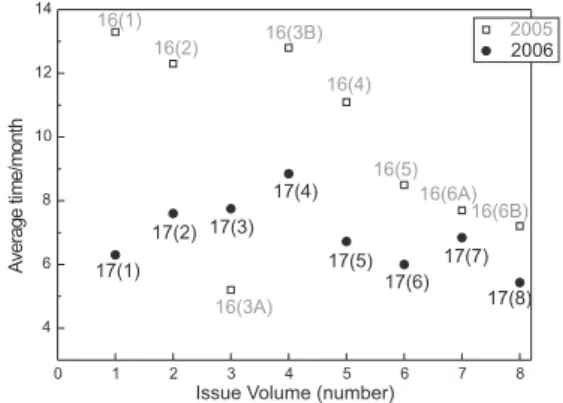Editorial
In the first JBCS of 2006, we stated that the growth of this Journal affirmed for that period, although significant with reference to previous years, could still be greater. What seemed like a simple bet, was seen to be all too true when the statistics for that last year were analyzed (please go to http://jbcs.sbq.org.br/ stats/07 for details on statistics): the number of manuscripts submitted to the JBCS jumped from 440 to 727, an increase of over 65%! This increase (best seen in Figure 1) is mostly due to the fact that there was a twofold increase in the number of foreign manuscripts submitted, which now accounts for 55% of the total number of manuscripts processed by the Journal.
This is to say that without a doubt, the JBCS is on the map of world Chemistry. This increase also confirms how right we were in our decision to publish eight numbers per year, and already leads us to predict an eventual review of how many issues per year should be considered for the future.
A further effect of this increase in the number of publications is the effort required to process these manuscripts by our editorial staff, the editors themselves, as well as the referees to the Journal. Once again, we may begin by recognizing the self-sacrifice and dedication of those involved who, with their already busy workloads, find time to contribute to the Journal. This is the keystone of any scientific Journal and stand for the guarantee for the publication of new and correct information that lead to the advancement of knowledge. Another important point to be highlighted is that today, the number of foreign referees surpasses 30% of the total.
A continually intense effort of our editorial staff has managed to prevent this rise in the number of manuscripts resulting in an increase in the average time needed for publication of the Journal, as may be seen in Figure 2. While a reduction in these times has not been so intense, we continue to process the submitted manuscripts more swiftly, now working in intervals of approximately six months. We continue to strive to reduce these times, always keeping in mind a special effort not to affect the quality of our review process and the refinement of the submitted manuscripts.
Since the JBCS is still limited in its capacity for the number of articles which may be published each year, this increase in the number of submissions has also been accompanied by an increase in our number of rejections. In certain cases of rejection, the comments of the referees and the editors have been such as to allow the authors to an improvement of the work they submit so
that these manuscripts could be published in the JBCS at a future opportunity or even in another journal. Nevertheless, in a good number of cases, we have noticed that the submitted work has been of quite a restricted, incomplete description, or even of a quality much below the state of the art of its area, which requires an unnecessary time expend of editors or referees. In other cases, there are manuscripts in which the emphasis of the work is more related to application, technology, or in which there is little or no relevant Chemistry information. These works fall outside the scope of the JBCS. While we recognize the importance of expanding the borders of our Journal in keeping with the ever important interdisciplinary studies which have been developed, it is a fundamental point in our policy that our Journal emphasize our role of publishing new and relevant information in which Chemistry takes the fundamental lead. Yet, with respect to the manuscripts submitted, we encourage the use of Supplementary Information material (SI) in the articles. This information is available on the Journal’s site, allowing a more complete evaluation of the manuscripts by the editors and referees and, after publication, the publicizing of important information such as data for the characterization of products and intermediaries, spectrum, tables and graphs with complete results. We wish to point out that different forms of information are acceptable as Supplementary Information, such as, for example, photographs, short films or animations.
We continue to strive towards continued growth of the periodical, with agility and the maintenance and perfection of those who work on its publication. Thus, we wish to inform the inclusion of Prof. Marília O. F. Goulart (Universidade Federal de Alagoas), on our Associate Editors staff, which will be of great importance in reaching our objectives. Let us take this opportunity to welcome Prof. Marília and wish her success in her undertakings!
Finally, we renew our wishes that this will be both another year of growth for our periodical and of new challenges. It is our hope that we may count on the support of all those who have been of such help in aspiring to ever greater conquests.
This is a special year in which the Sociedade Brasileira de Química celebrates the thirtieth anniversary of its beautiful history. Congratulations to the SBQ!
A happy 2007 to all!
Watson Loh and Luiz Carlos Dias Editors Figure 1. Evolution of manuscripts submitted and published in the JBCS.
